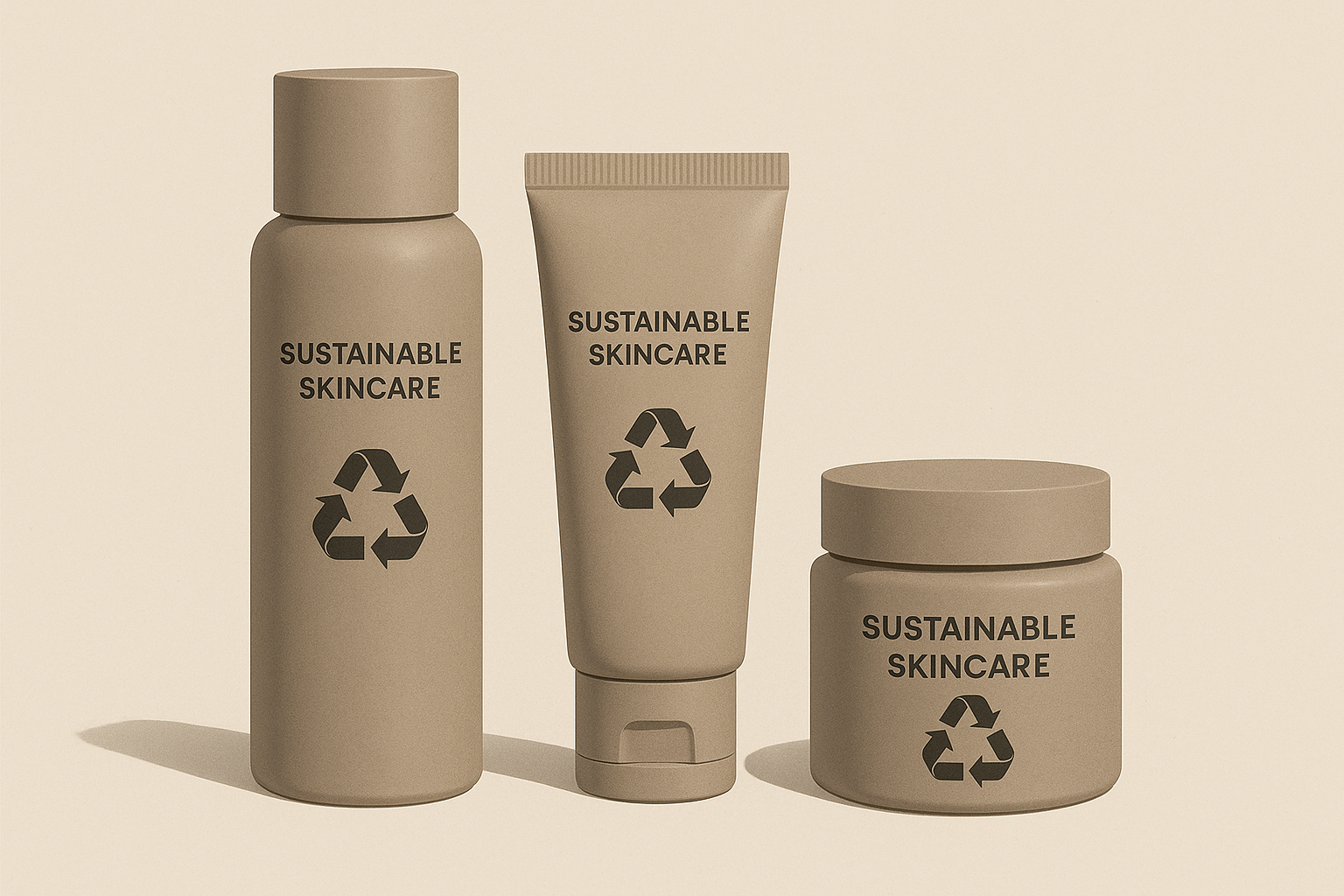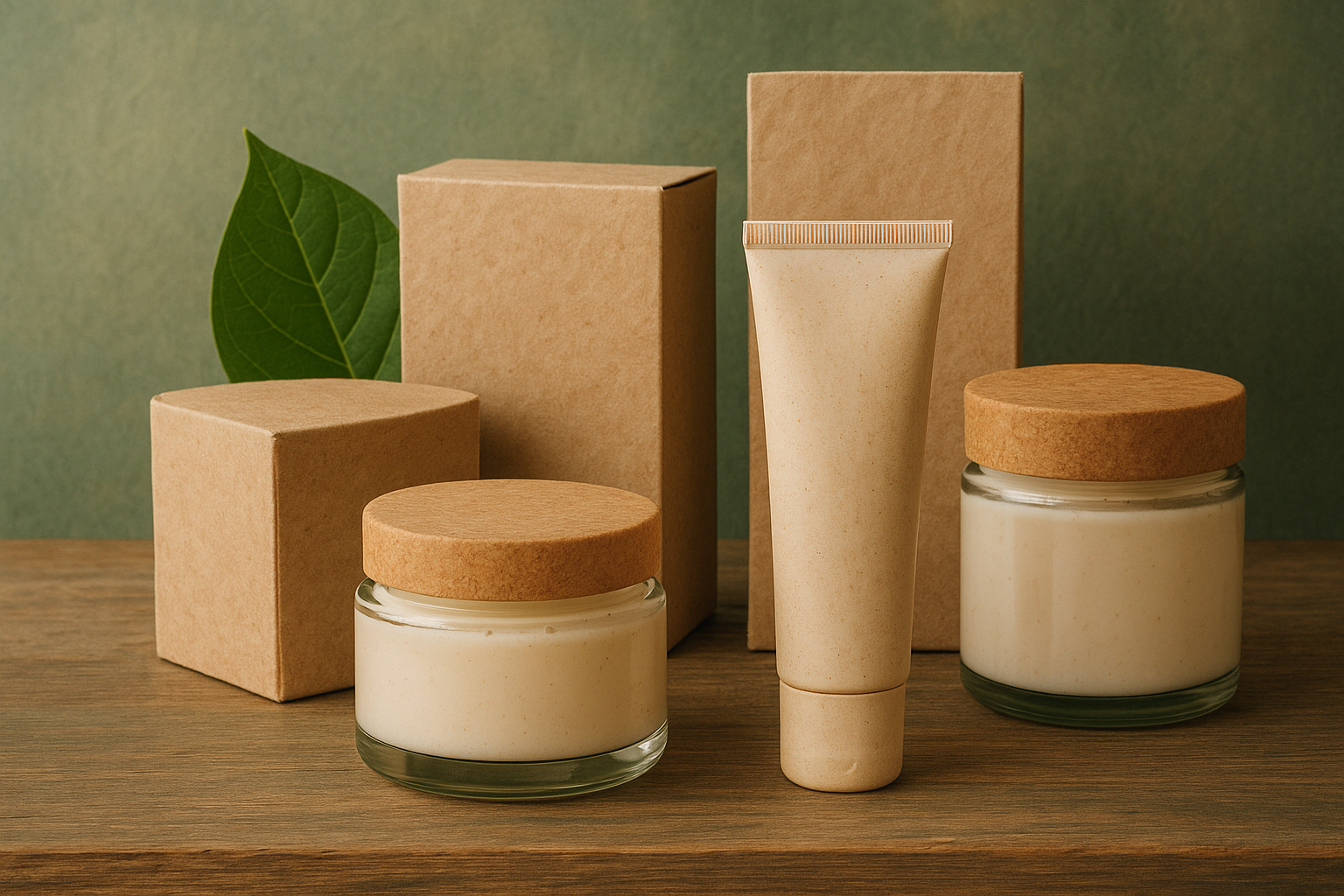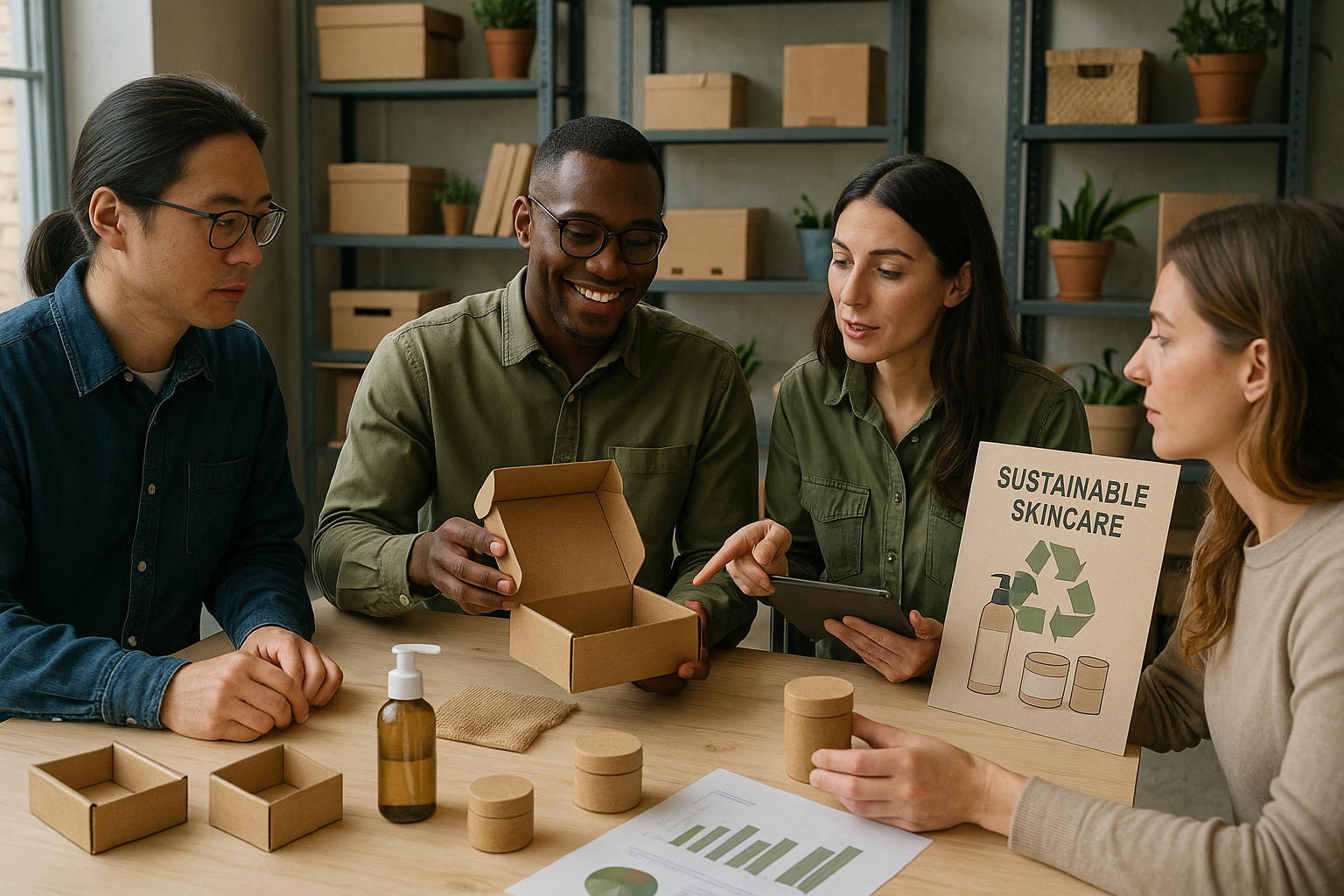
Sustainable Recyclable Skincare Packaging Tips: Elevate Your Eco-Friendly Routine
Share
It's no secret that skincare packaging accounts for billions of units annually, contributing significantly to environmental waste.
But what exactly are sustainable recyclable skincare packaging tips that can make a real difference?
Here’s a comprehensive cheatsheet packed with actionable insights for brands and consumers alike.
Some are simple material swaps that drastically cut carbon footprints.
Some are smart designs that make recycling intuitive and effective.
Some are innovative refillable and take-back systems creating true circularity.
Some combine luxury aesthetics with deep sustainability commitments.
Some harness partnerships with vetted, eco-conscious suppliers to guarantee integrity.
Let's dive right in.
Why Does Sustainable Skincare Packaging Matter?
Sustainable skincare packaging is more than a trend; it's a necessity for protecting our planet and nurturing skin health. Traditional plastic packaging often ends up in landfills or oceans, causing pollution and harming wildlife. Shockingly, only about 5-6% of plastic gets truly recycled globally, despite many products claiming to be recyclable. The rest pollutes ecosystems [York Container].
Eco-friendly packaging reduces a brand’s carbon footprint by conserving resources, lowering waste, and minimizing harmful emissions during production and transport. The personal care industry alone produces over 120 billion packaging units yearly, amplifying the urgency for change [BYBI].
Moreover, consumers are increasingly demanding transparency and sustainability from brands. Studies show 26% of consumers are more likely to showcase eco-friendly packaging online, and 32% equate it with higher product quality [Stephenson Personal Care]. Choosing sustainable skincare packaging signals commitment to ethical values, which cultivates loyalty and market differentiation.
How Can Brands Select Eco-Friendly Packaging Materials?
Choosing the right materials is the cornerstone of sustainable skincare packaging. Multiple options exist, each with pros and cons for environmental impact, cost, aesthetics, and product safety.
1. Glass: Infinitely Recyclable and Luxurious
Many premium skincare brands favour glass because it is derived from abundant natural resources like sand and can be recycled indefinitely without loss of quality. Printing labels directly on glass further eases recycling, as adhesive labels often contain plastics [BYBI].
However, glass is heavier than plastic, increasing transportation emissions and costs unless offset by recycled content. Innovating supply chains to use recycled glass significantly reduces energy consumption and carbon emissions during production.
2. Plant-Based Bioplastics: Sugarcane and Beyond
Some skincare formulations require plastic-like flexibility, making bioplastics derived from renewable sugarcane ethanol a practical alternative. These bioplastics are recyclable in traditional polyethylene streams and offer a lower carbon footprint compared to petroleum-based plastics. While not biodegradable, their renewability and carbon-neutral growth cycle represent meaningful improvements [BYBI].
3. Paper and Cardboard: Recycled and Compostable
Paper and cardboard packaging excels as biodegradable, lightweight, and easily recyclable options, often used for secondary packaging. Innovations like grasspaper use grass pulp requiring up to 80% less energy and significantly less water than traditional wood pulp, cutting CO2 emissions remarkably [BYBI]. Detailed recycling instructions printed on packaging improve consumer compliance.
What Are Best Practices for Designing Sustainable Packaging?
Design decisions are crucial for maximizing sustainability without compromising product protection or brand identity.
1. Minimalism in Design
Streamlined, fill-free packaging reduces waste and appeals to consumer preferences for simple elegance. Minimalistic designs also improve user experience and reduce materials use without sacrificing durability [York Container].
2. Optimized Size and Weight
Lightweight, compact packaging consumes less raw material and lowers shipping volume, cutting fossil fuel use and costs in logistics. This strategic sizing helps brands meet sustainability goals pragmatically.
3. Clear Recycling Labels and Education
Explicit, user-friendly waste disposal instructions on packaging empower consumers to recycle correctly. Use symbols and concise guidance to clarify composting vs recycling and to demystify disassembly requirements.

4. Smart and Interactive Packaging
Technologies like QR codes enrich the consumer experience by linking to brand sustainability stories, ingredient transparency, or recycling programmes. This fosters community, trust, and education all aligned with modern retail trends [Stephenson Personal Care].
How Can Refillable and Circular Packaging Boost Sustainability?
Luxury skincare brands are pioneering refill systems that promote circularity by extending packaging life cycles through reuse. Refillable packaging minimizes waste generation, transportation impact, and virgin material extraction.
An example is BYBI’s circular recycling programme for their booster bottles, which includes free returns labels and sterilization processes to turn empties into new containers, eliminating the need for newly produced plastic and lowering carbon emissions drastically [BYBI].
Such initiatives build emotional connections, encourage recycling behaviours, and position brands as leaders in responsible beauty.
What Are Effective Communication Strategies for Sustainable Packaging?
Communicating your sustainability efforts authentically is essential. Consumers respond to transparency and science-backed claims rather than vague buzzwords.
- Detail Certifications: Explain what COSMOS, vegan, cruelty-free, or compostable certifications mean in clear language.
- Share the Story: Embed the emotional narrative of why sustainable packaging matters and how it aligns with self-care and community.
- Guide Through Disposal: Use your packaging to educate on eco-friendly disposal to increase actual recycling rates.
- Highlight Environmental Impact: Provide stats or stories about how packaging choices reduce pollution and carbon footprint.
These approaches ground your brand ethos in empathy and science, resonating deeply with eco-conscious customers [Organic Tan Face and Body].
What Are Challenges and Strategies for Transitioning to Eco-Friendly Packaging?
Making a complete switch to sustainable packaging overnight can overwhelm operations and risk supply chain disruptions. Cost, logistics, and material performance are common concerns.
The recommended way is a phased approach:
- Audit Existing Packaging: Identify areas for improvement and realistic substitution targets.
- Collaborate Closely with Suppliers: Ensure partners share sustainability commitments and innovate solutions together.
- Test and Monitor: Validate new materials and designs for efficiency, branding, and customer feedback.
- Educate Internally and Externally: Align your team and customers to encourage buy-in.
- Leverage Incentives: Explore tax breaks, waste management fee reductions, and circular economy partnerships to offset costs [York Container].
This controlled strategy builds a sustainable foundation unlikely to falter or dilute your brand’s values.
What Are Sustainable Packaging Tips for Conscious Skincare Users?
Your role as a skincare enthusiast is pivotal in closing the loop of sustainable packaging.
- Choose products with packaging made of recyclable glass, aluminium, or responsibly sourced bioplastics.
- Prefer brands that provide refill options or take-back programmes.
- Rinse and clean containers before recycling to ensure material quality.
- Follow disposal instructions and separate compostables correctly.
- Support brands with visible, credible certifications and transparent sustainability stories.
By pairing conscious product choices with mindful disposal, you embody true self-care that honors both your skin and the planet.
Wondering how your routine can transform by opting for sustainable packaging? Here’s one tip: start by swapping one product packaging with recyclable alternatives. See how this inspires deeper eco-conscious habits.

How Do Certifications Influence Sustainable Skincare Packaging Decisions?
Certifications provide trust and guidance for brands and consumers. COSMOS certification, for example, guarantees organic and natural ingredients with strict packaging standards to support environmental sustainability and skin safety. This label assures that packaging uses recycled, recyclable, or biodegradable components wherever possible [Lulumine].
Other certifications include FSC for responsibly managed paper and cardboard and Cradle to Cradle for circularity in materials use. These badges provide measurable proof of impact, often exceeding regulatory minimums and reassuring sensitive skin users of gentle, toxin-free formulations.
Implementing recognized standards fosters industry accountability and empowers consumers to select truly sustainable products with confidence.
Can Sustainable Packaging Also Be Luxurious?
Absolutely. Luxury and sustainability are complementary when thoughtfully designed. Minimalistic, tactile glass or stone-based packaging combined with natural materials like hemp and water imbues a sense of pure elegance, free from excess waste [Stephenson Personal Care].
Refillable makeup packaging systems by brands such as Kjaer Weis marry opulence with conscious reuse, reinforcing that beauty need not cost the Earth.
Luxury packaging is no longer defined by layers of plastic or glittering trappings; rather, it is by quality materials, ethical values, and seamless user experience that amplifies brand storytelling.
How Can Supply Chain Commitment Enhance Packaging Sustainability?
True sustainability requires collaboration. Brands must partner exclusively with suppliers who uphold eco-friendly manufacturing processes, utilise renewable energy, and minimise carbon footprints through every step of production and transport [York Container].
Accurate forecasting prevents overproduction and over-purchasing of materials, reducing waste at the source. Transparent communication aligns all stakeholders toward shared ESG goals, strengthening the entire lifecycle's sustainability integrity.
This synergy is vital to maintain cost efficiency without sacrificing environmental responsibilities, especially for premium brands like Lulumine that prioritise organic, cruelty-free, and vegan values.
Table of Contents
- Why Does Sustainable Skincare Packaging Matter?
- How Can Brands Select Eco-Friendly Packaging Materials?
- What Are Best Practices for Designing Sustainable Packaging?
- How Can Refillable and Circular Packaging Boost Sustainability?
- What Are Effective Communication Strategies for Sustainable Packaging?
- What Are Challenges and Strategies for Transitioning to Eco-Friendly Packaging?
- What Are Sustainable Packaging Tips for Conscious Skincare Users?
- How Do Certifications Influence Sustainable Skincare Packaging Decisions?
- Can Sustainable Packaging Also Be Luxurious?
- How Can Supply Chain Commitment Enhance Packaging Sustainability?
Frequently Asked Questions
Is all recyclable packaging truly sustainable?
No. Some packaging labeled 'recyclable' might not be accepted by local facilities or may require complicated separation. True sustainability involves materials that can be recycled efficiently and reused, alongside efforts to reduce overall waste.
How can I ensure my skincare packaging is recycled properly?
Always clean containers before recycling, follow your local guidelines, and support brands that provide clear disposal instructions or take-back schemes.
Do refillable skincare products affect product safety?
Refillable packaging is designed with hygiene and shelf stability in mind. Brands using certified refill programs maintain sterilization protocols to ensure safety without compromising on sustainability.
Are biodegradable packaging options as effective as traditional materials?
Biodegradable packaging can protect products effectively but may have shorter shelf lives. Brands often combine biodegradable materials with innovative solutions to balance performance and environmental care.
Can sustainable packaging increase product costs?
Initially, sustainable materials may cost more, but savings in transport and waste management, alongside consumer goodwill and premium pricing, create a viable business case in the long term.
What's Your Next Step?
Tell us in the comments: How will you apply these sustainable recyclable skincare packaging tips to your eco-conscious beauty routine? For personalised advice, contact us!
Explore further how integrating sustainable recyclable skincare packaging tips complements the gentle and effective care of organic moisturizers designed for sensitive skin. The journey towards mindful beauty is rich with choices that honour skin and earth simultaneously.

Embarking on sustainable skincare packaging requires patience and innovation. From science-backed certifications to consumer-led awareness, every step matters in redefining beauty with respect for nature's balance.

